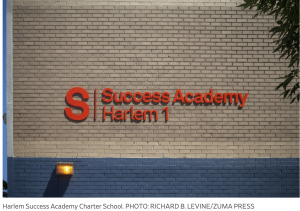For many years, it was widely believed that inner city black and brown students couldn’t compete with white students in school learning. Expectations were set low to give these students an excuse for underperforming in comparison to their white peers.
Then Eva Moskowitz, a former city council member, decided to challenge this conventional wisdom. She started a charter school in inner city Harlem New York where black and brown students had been failing for decades. Today, that charter school, and many others it spawned, is appropriately known as The Success Academy Charter School.
According to the New York Post, Success Academy had 17,700 applicants for 3,288 available seats, which resulted in a wait list of more than 14,000 families for the 2018–2019 school year.[7]The shortage of seats can be at least partly attributed to New York state educational policy. Robert Pondiscio, author of How The Other Half Learns (2019), which chronicles the structure and achievement of the Success Academy, believes that Moskowitz would quickly expand the system to 100 schools if the charter sector was not “hard up against the charter school cap in the State of New York”.
Two documentary films, The Lottery and Waiting for “Superman” record the intense desire of parents to enroll their children in Success Academy and charter schools like Success Academy. By 2019, according to The Washington Post, the Success Academy network of 47 schools serving 17,000 students, is the “highest-performing and most criticized educational institution in New York”, and perhaps in the United States. Mayor Michael Bloomberg said that the Harlem Success Academy was “the poster child for this country.” President Barack Obama also recognized charter schools as being crucial in reforming the education system.
The latest evidence of the success of this charter school is documented in The Wall Street Journal. The editorial board says students are so eager and prepared to take the upcoming Advanced Placement (AP) exams – 1,317 of them – that the school has had to rent space in New York’s Javits Center. That’s the venue where they have events like the international auto show, where Hillary Clinton planned to have her presidential post-election celebration (that didn’t happen!), and where plans were made for handling the anticipated (but not needed) extra space to care for sick patients at the height of the Covid pandemic.
AP subjects range from chemistry and art history to biology and calculus, and some Success Academy students will sit for as many as five exams. The WSJ editors say, “Implicit in the rejection of testing now popular even at elite universities such as Harvard and Princeton is the idea that low-income children of color can’t succeed. The Success Academy student body is overwhelmingly black and Latino. But whether it’s the AP exams or the SATs, its students welcome standardized tests as an opportunity to prove what they have learned. Success knows that black and Latino children often lag behind their white peers. But it believes the answer is to bring their achievement up—rather than dumbing down or eliminating tests, which leaves them unprepared for college work.”
Is it working?
It seems to be working: U.S. News & World Report ranked Success’s Manhattan high school tied for first in the nation for college readiness, because 100% of seniors had passed at least one AP exam over their four years of high school.
“With rampant grade inflation and inconsistent state educational standards, AP and SAT tests are a critical tool in identifying students who are prepared for the rigors of college,” says Success Academy founder and CEO Eva Moskowitz. “This is especially true for low-income children of color. Attacking these tests does nothing except undermine the important work of helping disadvantaged students do better on these tests.”
Isn’t it great to read a good news story at least once in a while?


